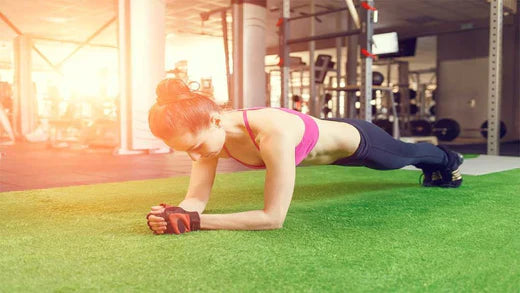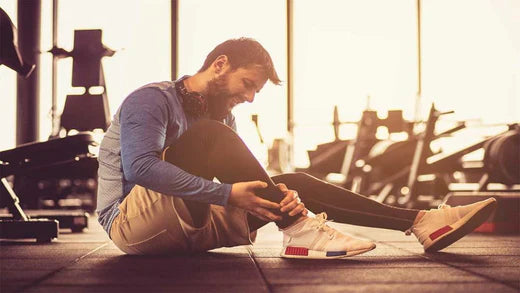Importance de la force musculaire dans les entraînements de CrossFit

Pourquoi des abdominaux forts sont votre arme secrète en CrossFit
Les entraînements CrossFit exigent que tout le corps soit synchronisé. Il n'y a pas de mouvements isolés. Le haut et le bas du corps doivent être en phase pour réaliser un exercice en toute sécurité. Quel est le lien entre les deux moitiés du corps ? Le tronc.
Tous les mouvements proviennent du tronc. Si votre tronc est faible, vous ne pourrez pas exécuter correctement la plupart des exercices olympiques du CrossFit. Mais surtout, vous vous exposez à un risque de blessure.
Pour optimiser vos performances et vos résultats lors de vos entraînements CrossFit , votre ceinture abdominale doit être une priorité. Renforcer votre ceinture abdominale va au-delà des abdominaux. Examinons les muscles qui la composent, les avantages d'une ceinture abdominale renforcée et des moyens simples de l'améliorer.
QU'EST-CE QUE « LE NOYAU » ?
Avant d'aborder les avantages d'une ceinture abdominale musclée en CrossFit, clarifions la signification du terme « core ». La plupart des gens pensent que le « core » désigne l'avant des abdominaux, ou les muscles génitaux. Or, ce n'est qu'une partie de ce qui constitue le tronc. Les principaux muscles qui le composent sont les suivants :
Grand droit de l'abdomen : les abdominaux classiques. Cette longue bande musculaire est située à l'avant et au centre.
Muscle transverse de l'abdomen : Couche musculaire la plus profonde du tronc, le muscle transverse de l'abdomen est situé sous le grand droit de l'abdomen. Il part des hanches, traverse les côtes et s'enroule autour. On peut le comparer à une ceinture musculaire.
Obliques internes et externes : il s’agit de tissu musculaire qui longe vos côtes.
Multifidus : Muscle fin, surtout comparé au transverse de l'abdomen, qui longe la colonne vertébrale et aide à la stabiliser.
Muscle érecteur du rachis : Autre muscle de la colonne vertébrale, le muscle érecteur du rachis fait plus que stabiliser, il vous permet également de tourner et de vous tordre d'un côté à l'autre.
Muscles du plancher pelvien : Situés dans l’os du bassin, ces muscles sont importants pour le contrôle de la vessie. (Nous aide à éviter les accidents urinaires/intestinaux)
Bien qu’il s’agisse des principaux muscles qui composent le tronc, les fessiers, les fléchisseurs de la hanche et le bas du dos doivent également être pris en compte lors des entraînements pour garantir une force et une stabilité bien équilibrées.
LES AVANTAGES DE LA FORCE CENTRALE EN CROSSFIT
Cibler sa ceinture abdominale offre l'avantage évident d'avoir un ventre plat et sexy, qui attirera tous les regards pendant la saison des vacances à la plage. Au-delà de l'esthétique, avoir une ceinture abdominale musclée présente de nombreux avantages fonctionnels, notamment pour vos entraînements de CrossFit .
Élimine la surcompensation : Le tronc étant le lien entre le haut et le bas du corps, la surcompensation musculaire diminue. Lorsqu'un muscle fort prend le relais d'un muscle plus faible, on parle de surcompensation. En trouvant un meilleur équilibre entre les groupes musculaires, vous n'aurez plus à vous soucier d'une partie du corps en retard, que ce soit pour la force ou l'esthétique.
Aide à contrôler les mouvements fonctionnels : Comme mentionné précédemment, tous les mouvements proviennent du tronc. De plus, de nombreux exercices font appel au tronc pour l'équilibre. Pour maîtriser les mouvements fonctionnels et tous les exercices de CrossFit, comme l'équilibre au mur ou le clean and press, il est essentiel de renforcer le tronc. En vous concentrant sur le renforcement de votre tronc, vous pourrez réussir votre WOD sans difficulté.
Risque de blessure réduit : Plus important encore, une ceinture abdominale solide réduit le risque de blessure. Les entraînements de CrossFit ne sont pas à prendre à la légère. Ils reposent sur de nombreux exercices de type olympique, qui peuvent facilement causer des blessures s'ils sont mal exécutés. Une ceinture abdominale solide permet à votre corps de supporter la charge et de se stabiliser pendant ces exercices.
En dehors d'un noyau solide, une autre façon de promouvoir de meilleurs résultats et la sécurité en même temps est d'utiliser des équipements CrossFit courants tels que des bandages pour poignets , des genouillères et des sangles de levage .
COMMENT AMÉLIORER LA FORCE DU TRONC
Vous pouvez identifier tous les muscles de votre ceinture abdominale et comprendre pourquoi il est si important de la solliciter en priorité lors de vos entraînements. Alors, comment pouvez-vous améliorer votre force abdominale ?
Privilégiez les pauses et les contractions : Bien que le CrossFit soit un exercice rapide pour les abdominaux, il est important de privilégier les phases de pause et de contraction. Par exemple, prenez votre temps pour abaisser votre corps ou votre poids et ressentez la tension des muscles abdominaux. Lorsque vous arrivez à la partie isométrique ou à la pause, arrêtez-vous et contractez les muscles abdominaux, puis revenez au point de départ.
Pratiquez des exercices de torsion : L'un des meilleurs moyens de renforcer votre ceinture abdominale est de réaliser des exercices impliquant un mouvement transversal. Intégrez des exercices de torsion à votre routine, comme le woodchopper, qui démarre au-dessus des épaules et se poursuit jusqu'à l'autre côté du bas du corps. Non seulement cela renforce votre ceinture abdominale, mais cela améliore également les mouvements fonctionnels au quotidien, comme attraper une boîte sur une étagère et la tendre à quelqu'un derrière vous en effectuant une torsion.
Pensez au-delà de vos abdominaux : Comme nous l'avons vu précédemment, le tronc ne se limite pas à vos abdominaux. Il est important d'élargir votre définition du « tronc » et d'inclure les muscles situés juste au-delà de cette zone. Par exemple, les fléchisseurs de la hanche, le bas du dos et les fessiers. Intégrer ces muscles à vos exercices de gainage contribuera à équilibrer force et stabilité.
MEILLEURS EXERCICES DE RENFORCEMENT DU TRONC
En parlant d'exercices de base, voici cinq mouvements qui sollicitent l'ensemble de la musculature abdominale. De plus, ils couvrent une gamme variée de tempos, d'intensités et de volumes.
ESSUIE-GLACES
Cet exercice au nom insolite sollicite presque tous les muscles du tronc et met à l'épreuve votre force autant que votre endurance. Allongez-vous sur le dos, les bras tendus le long du corps et les mains fermement au sol. Joignez les pieds et levez les jambes vers le ciel. Votre corps formera un « L ». En gardant les jambes dans cette position, tournez-les sur le côté jusqu'à ce qu'elles touchent presque le sol. Contractez les abdominaux pour amener les jambes de l'autre côté. Déplacez les jambes vers la gauche, puis vers la droite pour une répétition.
PONT
L'exercice du pont sollicite les fessiers, les fléchisseurs de la hanche et le bas du dos ; il sollicite néanmoins le grand droit et le transverse de l'abdomen. Pour réaliser l'exercice du pont, allongez-vous au sol, les genoux fléchis. Les bras le long du corps. Contractez les muscles abdominaux en soulevant les hanches vers le ciel. Contractez les fessiers pour accentuer le mouvement. Marquez une pause en haut du mouvement, puis redescendez lentement les hanches. Ne laissez pas vos fesses toucher le sol ; passez à la répétition suivante.
BÛCHERON
L'exercice du bûcheron, mentionné précédemment, vous fait parcourir le plan transversal, renforçant ainsi votre ceinture abdominale tout en améliorant votre contrôle moteur. Placez une poulie à câble aussi haut que possible. Saisissez la poignée à deux mains et tournez-la de manière à ce que votre corps soit parallèle à la poulie. Lentement, amenez la poignée devant vous et vers le bas. Une fois vos mains à l'opposé du bas du corps, marquez une pause et contractez la ceinture abdominale. Revenez lentement à la position de départ.
PLANCHE
Véritable test de force, de stabilité et d'endurance, la planche est un exercice intense, mais ne nécessite aucun mouvement. Bouger est la dernière chose que vous souhaitez. Mettez-vous en position de pompe, pieds tendus derrière vous. Le haut du corps repose sur vos avant-bras. Soulevez légèrement les hanches et concentrez la contraction de la ceinture abdominale. Maintenez la posture. Ne relâchez pas les hanches ; l'exercice est alors terminé.
BURPEES
Un incontournable du CrossFit, le burpee combine plusieurs mouvements en un seul. Excellent pour améliorer les mouvements fonctionnels de tout le corps et renforcer la ceinture abdominale. Debout, agenouillez-vous et posez vos mains au sol devant vous. Reculez vos pieds en position de pompe. Effectuez une pompe, sautez et ramenez vos pieds vers vos mains. De retour à genoux, décollez du sol en l'air, bras levés. Retombez doucement sur vos pieds. Une répétition suffit.
ASPIRATION ASSIS
Gardez cet exercice pour la fin de votre séance de gainage. Asseyez-vous par terre ou sur une chaise confortable. Tenez-vous droit, les épaules en arrière. Inspirez profondément par le ventre, puis expirez autant que possible. Continuez à expirer même si vous avez l'impression de ne plus avoir de souffle. Pendant ce temps, rentrez votre nombril et rapprochez-le de votre colonne vertébrale. Vous ressentirez une contraction musculaire intense au plus profond de votre corps. Concentrez-vous sur cette contraction et essayez de l'accentuer encore davantage. Vous finirez par manquer de souffle, et cela se terminera après une seule répétition.
ENTRAÎNEMENT DE FORCE CENTRALE
En dehors de vos entraînements CrossFit, essayez cet entraînement de renforcement du tronc :
- Dead Bug : 3 séries de 15 répétitions
- Pont : 3 x 15
- Bûcheron : 3 x 12
- Planche : 2 x 60 secondes
- Burpees : 2 x 5
- Vide assis : 1 x Panne
QUELS SONT VOS EXERCICES DE BASE PRÉFÉRÉS ?
Préférez-vous les exercices de gainage rapides comme le burpee ? Ou préférez-vous les tests d'endurance et la planche ? Partagez-les avec nous sur Facebook !


